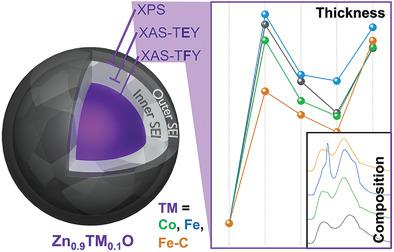当前位置:
X-MOL 学术
›
Small Methods
›
论文详情
Our official English website, www.x-mol.net, welcomes your
feedback! (Note: you will need to create a separate account there.)
Impact of the Transition Metal Dopant in Zinc Oxide Lithium‐Ion Anodes on the Solid Electrolyte Interphase Formation
Small Methods ( IF 10.7 ) Pub Date : 2021-01-15 , DOI: 10.1002/smtd.202001021 Tobias Eisenmann 1, 2 , Jakob Asenbauer 1, 2 , Seyed Javad Rezvani 3, 4 , Thomas Diemant 1, 5 , Rolf Jürgen Behm 1, 5 , Dorin Geiger 6 , Ute Kaiser 6 , Stefano Passerini 1, 2 , Dominic Bresser 1, 2
Small Methods ( IF 10.7 ) Pub Date : 2021-01-15 , DOI: 10.1002/smtd.202001021 Tobias Eisenmann 1, 2 , Jakob Asenbauer 1, 2 , Seyed Javad Rezvani 3, 4 , Thomas Diemant 1, 5 , Rolf Jürgen Behm 1, 5 , Dorin Geiger 6 , Ute Kaiser 6 , Stefano Passerini 1, 2 , Dominic Bresser 1, 2
Affiliation

|
Conversion/alloying materials (CAMs) provide substantially higher specific capacities than graphite, the state‐of‐the‐art lithium‐ion battery anode material. The ability to host much more lithium per unit weight and volume is, however, accompanied by significant volume changes, which challenges the realization of a stable solid electrolyte interphase (SEI). Herein, the comprehensive characterization of the composition and evolution of the SEI on transition metal (TM) doped zinc oxide as CAM model compound, is reported, with a particular focus on the impact of the TM dopant (Fe or Co). The results unveil that the presence of iron specifically triggers the electrolyte decomposition. However, this detrimental effect can be avoided by stabilizing the interface with the electrolyte by a carbonaceous coating. These findings provide a great leap forward toward the enhanced understanding of such doped materials and (transition) metal oxide active materials in general.
中文翻译:

氧化锌锂离子负极中过渡金属掺杂剂对固体电解质界面形成的影响
转换/合金材料 (CAM) 提供比最先进的锂离子电池负极材料石墨更高的比容量。然而,每单位重量和体积承载更多锂的能力伴随着显着的体积变化,这对实现稳定的固体电解质界面(SEI)提出了挑战。本文报道了作为 CAM 模型化合物的过渡金属 (TM) 掺杂氧化锌上 SEI 的组成和演变的综合表征,特别关注 TM 掺杂剂(Fe 或 Co)的影响。结果揭示了铁的存在特别触发了电解质的分解。然而,可以通过碳质涂层稳定与电解质的界面来避免这种不利影响。
更新日期:2021-01-15
中文翻译:

氧化锌锂离子负极中过渡金属掺杂剂对固体电解质界面形成的影响
转换/合金材料 (CAM) 提供比最先进的锂离子电池负极材料石墨更高的比容量。然而,每单位重量和体积承载更多锂的能力伴随着显着的体积变化,这对实现稳定的固体电解质界面(SEI)提出了挑战。本文报道了作为 CAM 模型化合物的过渡金属 (TM) 掺杂氧化锌上 SEI 的组成和演变的综合表征,特别关注 TM 掺杂剂(Fe 或 Co)的影响。结果揭示了铁的存在特别触发了电解质的分解。然而,可以通过碳质涂层稳定与电解质的界面来避免这种不利影响。











































 京公网安备 11010802027423号
京公网安备 11010802027423号